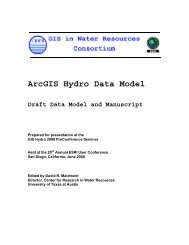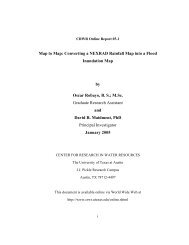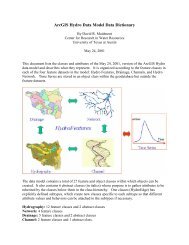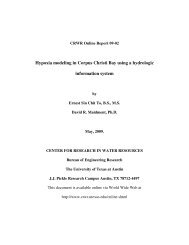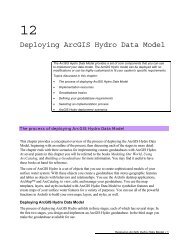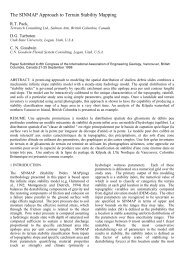View the Whole Report - Center for Research in Water Resources ...
View the Whole Report - Center for Research in Water Resources ...
View the Whole Report - Center for Research in Water Resources ...
You also want an ePaper? Increase the reach of your titles
YUMPU automatically turns print PDFs into web optimized ePapers that Google loves.
6. CONCLUSIONS AND RECOMMENDATIONS<br />
The <strong>in</strong>ventory of temporary runoff controls on TxDOT construction sites<br />
<strong>in</strong>dicated that silt fences and rock berms were <strong>the</strong> most commonly used runoff controls on<br />
construction sites. Rock berms were used to treat <strong>the</strong> dra<strong>in</strong>age from 53% of <strong>the</strong> area of<br />
<strong>the</strong> six sites <strong>in</strong> <strong>the</strong> study area. Silt fences and sedimentation ponds were <strong>the</strong> next most<br />
common runoff controls treat<strong>in</strong>g 23% and 22% of <strong>the</strong> total area, respectively. Sediment<br />
ponds were <strong>the</strong> most <strong>in</strong>expensive control on a cost per area basis and were used more<br />
frequently <strong>in</strong> <strong>the</strong> earlier stages of construction. Erosion control blankets were <strong>the</strong> most<br />
expensive controls and tended to be used <strong>in</strong> <strong>the</strong> later phases of construction.<br />
Field evaluation of <strong>the</strong> efficiency of silt fences <strong>in</strong> remov<strong>in</strong>g sediment <strong>in</strong> runoff<br />
from highway construction runoff showed that <strong>the</strong> median removal due to filtration was<br />
0%. Additional removal occurred due to particle settl<strong>in</strong>g, but was not quantified <strong>in</strong> <strong>the</strong><br />
field portion of <strong>the</strong> study. The median concentration of solids discharged from <strong>the</strong> silt<br />
fence controls was approximately 500 mg/L. Geotextile silt fences also proved to be<br />
<strong>in</strong>effective <strong>in</strong> reduc<strong>in</strong>g turbidity. The median turbidity reductions <strong>for</strong> <strong>the</strong> sites monitored<br />
was about 2%. Monitor<strong>in</strong>g of a s<strong>in</strong>gle rock berm also showed negligible TSS removal.<br />
The poor filtration per<strong>for</strong>mance of <strong>the</strong> geotextile fabrics alone <strong>in</strong>dicates <strong>the</strong><br />
disparity between test efficiency and actual field per<strong>for</strong>mance. The bulk of <strong>the</strong> difference<br />
could be credited to an unrealistic particle size distribution <strong>in</strong> <strong>the</strong> slurry mixtures of<br />
previous laboratory studies. Silt and clay size particles were <strong>the</strong> primary constituents of<br />
construction site generated sediment <strong>in</strong> this study. The observed data <strong>in</strong>dicated that silt<br />
and clay size particles comprised 92% of <strong>the</strong> total suspended solids.<br />
The field efficiency of silt fences appears to be dependent ma<strong>in</strong>ly on <strong>the</strong> detention<br />
time of <strong>the</strong> runoff beh<strong>in</strong>d <strong>the</strong> control. The detention time is controlled by <strong>the</strong> geometry of<br />
<strong>the</strong> upstream pond, hydraulic properties of <strong>the</strong> fabric, and ma<strong>in</strong>tenance of <strong>the</strong> control.<br />
Despite comments by project supervisors that little ma<strong>in</strong>tenance of controls was required,<br />
numerous <strong>in</strong>stallation and ma<strong>in</strong>tenance deficiencies were noted dur<strong>in</strong>g <strong>the</strong> study. Holes<br />
<strong>in</strong> <strong>the</strong> fabric and <strong>in</strong>adequate “toe-<strong>in</strong>s” that result <strong>in</strong> under-runs reduced <strong>the</strong> detention time<br />
available <strong>for</strong> particle settl<strong>in</strong>g. In addition, <strong>the</strong> open<strong>in</strong>gs released <strong>the</strong> discharge <strong>in</strong> a<br />
53




